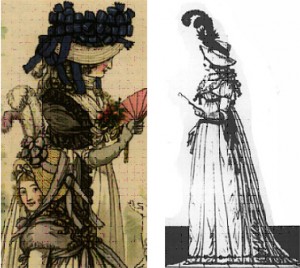A Fashionable Chip Hat
While researching material for our latest magazine we copied part of a report on the fashionable wedding in Ryde between George Godwin Stancomb and Miss Elizabeth Alty in 1880.
‘The bride’s travelling costume was of fawn coloured cashmere, trimmed with gold brochade; hat was chip with ostrich feathers to match.’
When checking the draft magazine document we thought ‘hat was chip’ must be a typing error. However it could hardly mean ‘hat was cheap,’ perhaps ‘hat was chic’ but was that a word used in 1880! Back to Ann, our research expert who confirmed from the original document that there was no error and actually chip hats have been mentioned in other fashion reports.
Next stop, the dictionary:
• wood or Cuban palm leaf split into slips, or straw plaited in a special manner, for making hats or bonnets.
• a thin strip of wood or straw used for making woven hats, baskets, etc. Wood, palm leaves, straw, or similar material cut and dried for weaving.
We even found a classic literature link:
‘With the money that I get from the sale of these eggs I’ll buy myself a new dimity frock and a chip hat; and when I go to market, won’t all the young men come up and speak to me?’ (extract from Aesop’s Fables)
After that we wanted more fashion information and some images:
The image on the left is from the June 1794 Issue of ‘The Gallery of Fashion.’ It shows a two chip hats one a “Straw-coloured gipsy hat, trimmed with lilac riband” and the other is a “Plain chip hat, trimmed with purple ribands.”
The image on the right is from the August 1794 Issue of ‘The Gallery of Fashion.’ It shows a lady in half-mourning – Head-dress: white chip hat bound with black, and trimmed with a piece of black silk; two black feathers placed on the right side, near the front. The toupee combed straight, and the hair behind in ringlets.”
Sources:
Isle of Wight Times 10 June 1880; dictionary.die.net; thefreedictionary.com
The main image is from Late Victorian Era Clothing blogspot and the lady second in from the right is dressed in “Walking Dress of Thin, White Figured Muslin, made over thin, pink cambric. The skirt is laid inkilt-plaitings all around, and is edged with a knife-plaiting. The coat-waist is made very deep, and is slightly caught up in the back; it is edged with white cambric edging turned up on the coat. White chip hat, trimmed with pink ribbon and a long white feather. White muslin parasol made over pink silk.”


